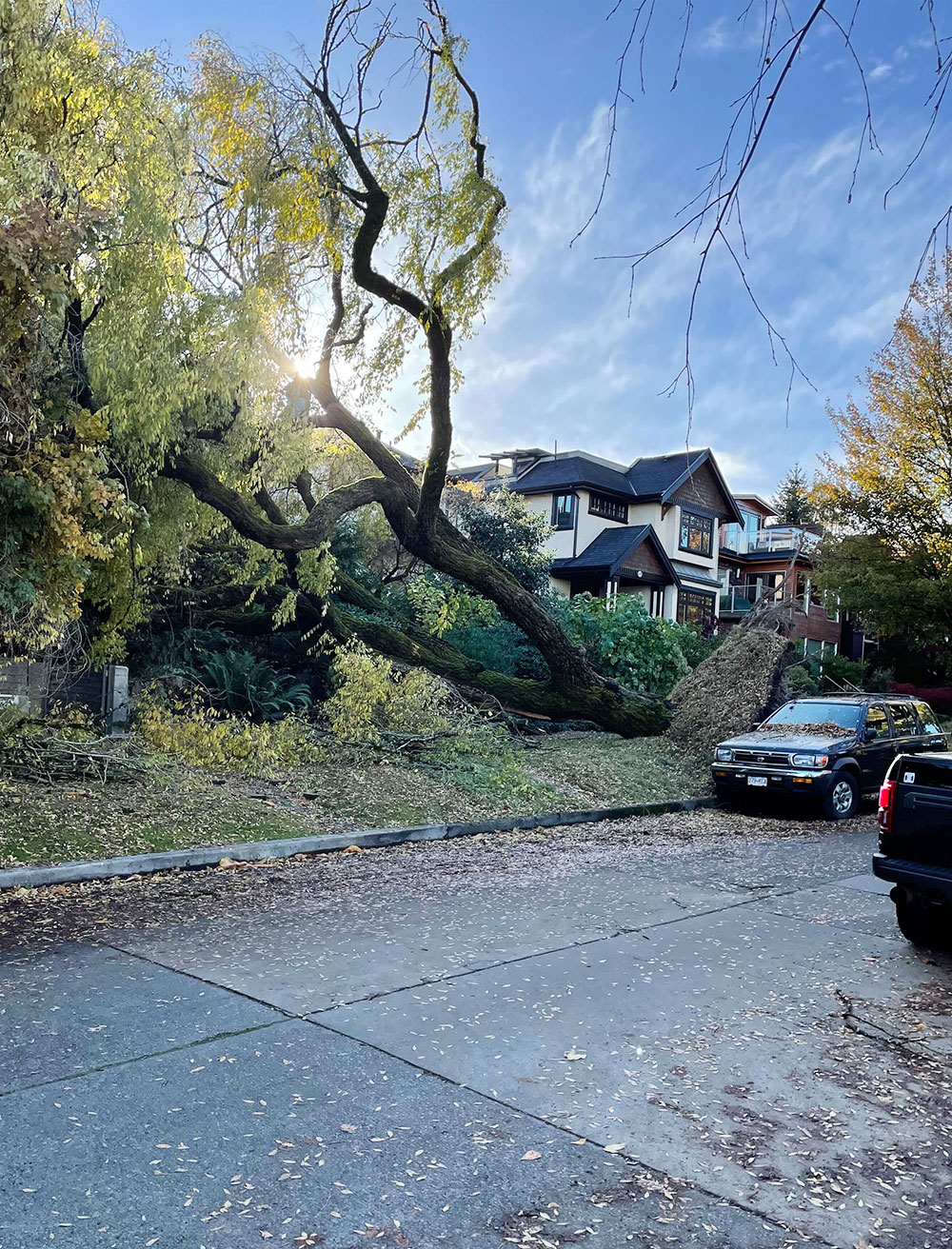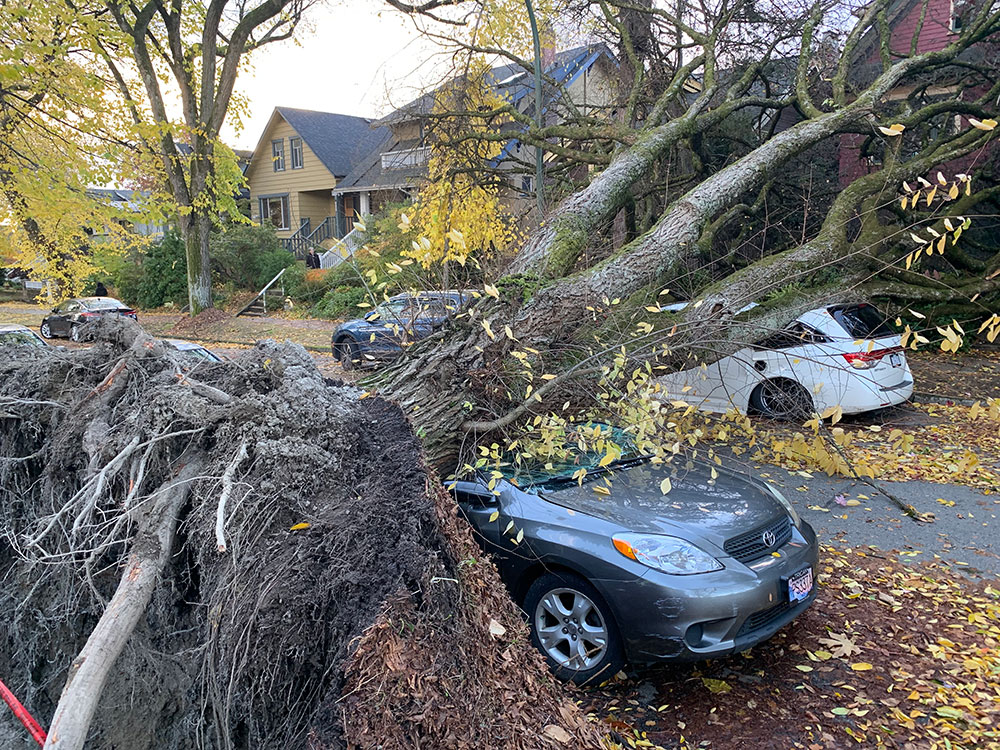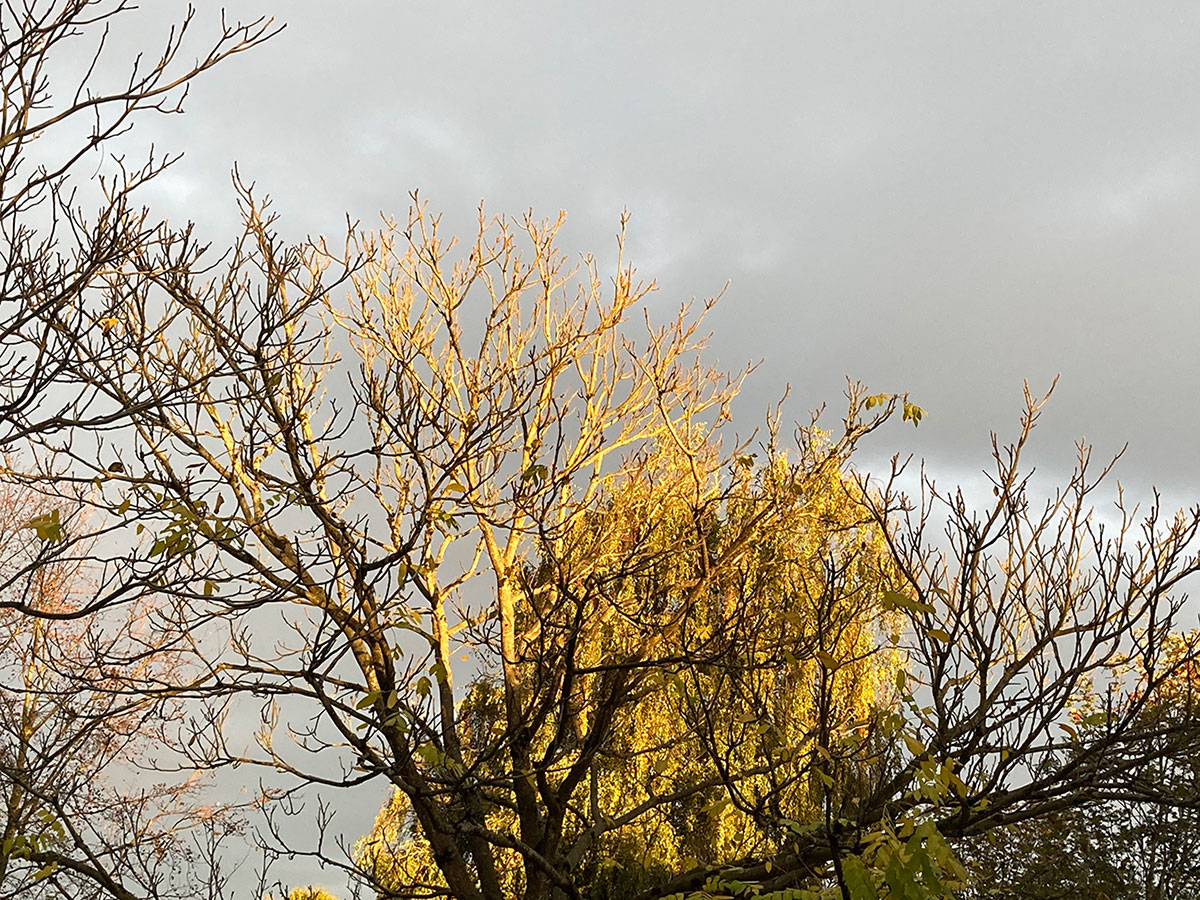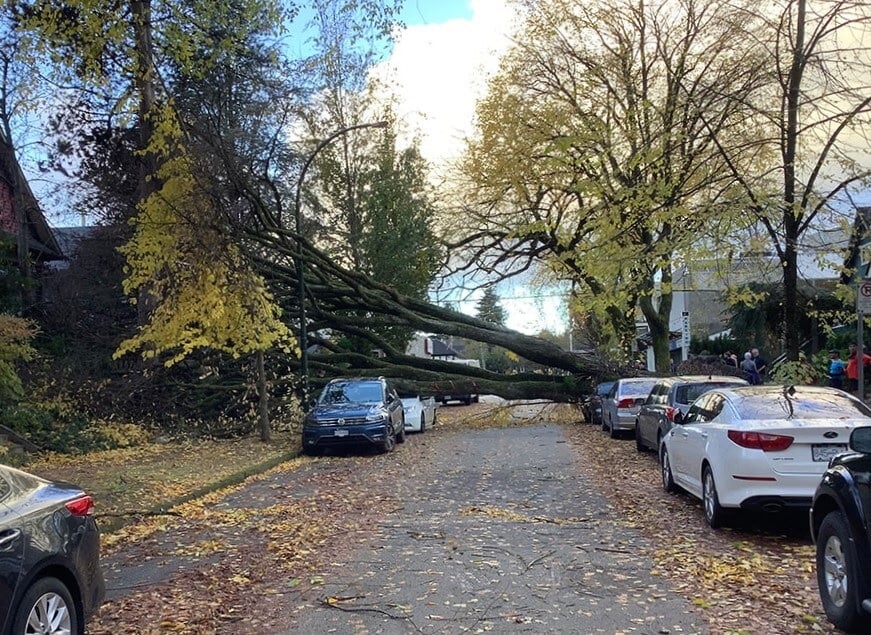It was around one in the morning when Leigh was awakened by a boom.
A large maple tree has loomed over the front of Leigh’s home since he moved in about 10 years ago. He declined to share his last name for privacy reasons. Throughout the years, city officials have stopped by to trim the tree, though it had never shown any signs of weakness during previous storms.
But when he opened his front door to examine his yard on Vancouver’s west side, the maple’s branches were just metres from his face.
“I was opening the door and it was like a jungle in front of my house,” Leigh said.

The tree was just one of 500 tree-related incidents — including uprooted trees, broken branches and debris — that were recorded by the City of Vancouver during the Nov. 4 windstorm, the city’s first big storm of the fall.
Downed trees caused over 300,000 homes to lose power in southwestern B.C. The damage also extended to parked cars and homes, blocking many arterial streets.
Eva Cook, a communications specialist with the Vancouver Park Board, told The Tyee in an email that a majority of the Nov. 4 incidents involved “minor, small to medium-sized debris.” However, there were larger incidents that impacted streets and properties.
“Crews are also dealing with whole trees that have uprooted and impacted private property, power lines and major thoroughfares across the city,” Cook said.
November often brings these kinds of storm-related events to B.C.’s south coast, yet climate change is exacerbating its impact on Vancouver’s street trees.
Normally in early November, Vancouver’s deciduous trees would have lost their leaves due to colder weather. Because of the historic fall drought — which saw temperatures jump over 20 degrees into mid-October — many of Vancouver’s trees still had their leaves, making them vulnerable to the windstorm.
“These leaves act as miniature sails,” Cook said. “Causing trees to be more forcefully blown around, contributing to higher impacts.”

Where did the street trees come from?
Long before European settlers colonized Vancouver, the region was a dense rainforest that was home to the Musqueam, Squamish and Tsleil-Waututh nations. By the 1800s, though, European settlers had colonized Vancouver and much of North America.
The colonizers used a European approach to construct Vancouver, says David Tracey, an environmental writer and founder of Tree City, a non-profit organization that has helped plant thousands of trees in Vancouver’s urban forest.
Trees were cut to make space for streets and buildings.
“You cut down all the trees and then you build new housing developments,” Tracey said. “Then you call streets by tree names — Arbutus, Yew, all those ones — you try to replace the forest itself with names.”
In Europe, the concept of planting street trees dates back to the 18th century when France and England tested the idea to reconnect people to nature. Tracey said that the English in particular had a fascination with plants and frequently travelled to other countries to gather plants to see if they would grow in Europe.
“When they came here, they brought that same interest in a pretty eclectic view of plants and trees,” he said. “We inherited all of that when the colonizers first came.”
So when settlers came to North America, they brought their variety of plants with them.
In Vancouver, specifically, Tracey says the city has a “mixed urban forest” with hundreds of different tree species ranging from cherry blossoms that originated in Asia to western red cedar trees which are native to the Pacific Northwest.
The first bylaw permitting street trees passed in 1896, when the city deemed the trees necessary for shade. They also used the trees to build character alongside busy street corridors, and roughly three decades later, the city hired hundreds of unemployed men to plant trees alongside 103 kilometres of boulevards.
Additionally, according to Atlas, an undergraduate journal of world history at UBC, the city encouraged residents to plant their own trees by offering 50 cents for every tree they planted.
Boosting the tree canopy will help us cope with climate change
Vancouver currently has about 160,000 street trees and up to 1,000 are removed annually due to old age, health issues or storm damage.
For 20 years, Stephen Sheppard, a professor at the University of British Columbia’s faculty of forestry, has researched the health of Vancouver’s urban forest and how to plan for climate change.
Trees lower air pollution, Sheppard said, and serve as an easy access to nature which can improve mental health.
To help cope with climate change, boosting the tree canopy will provide cool spaces for people in heat waves and reduce stormwater runoff during heavy rainstorms.
“[Trees] can reduce temperatures by several degrees if they’re at the neighbourhood scale of 40 per cent canopy cover,” Sheppard said.
When Tracey founded Tree City in 2005, he wanted to help build Vancouver’s tree canopy and educate people about the benefits of trees.
One of the goals in Vancouver’s Greenest City 2020 plan, which was established in 2010, was to plant 150,000 trees by 2020.
Tracey said the city reached out to him to see if he could help reach the target. In 2013, he launched a community program, TreeKeepers, which added almost 9,000 trees to Vancouver’s tree canopy in two and a half years and educated residents about the urban forest and arboriculture.
Their education program had six modules — such as identifying healthy trees, watering techniques and planting — that earned citizens a "citizen forester" sheriff star upon completion.
“We wanted the citizenry, the people of Vancouver, to be knowledgeable, passionate advocates for trees in the city.”
How to plant amid climate change
In December 2020, the Vancouver Park Board set an ambitious goal of raising the city’s tree canopy from 23 to 30 per cent by 2050.
Sheppard says the city’s plan to reach that number is laudable, but will be hard to achieve with the lack of space in Vancouver and the dichotomy between zoning and green space plans.
“It would be nice to get to 40 per cent [tree canopy] but that’s never going to happen,” Sheppard said. “It’s really hard not to see the conflict between plans like the Broadway Plan and the kinds of densification and population increase that is expected with the canopy targets.”
Sheppard adds that a majority of the trees that are falling down in extreme weather events are older trees.
On Nov. 29, during Vancouver’s first major snowfall of the year, a plethora of trees and branches toppled under the weight of snow — causing damage to cars and roads, and power outages.
To sustainably grow Vancouver’s urban forest, he says, proper supervision such as regular watering and street designs that foster root growth will help street trees live longer.
Although climate change threatens to increase the frequency of droughts and extreme wind-related events, the city is focused on planting more trees — specifically ones that are resilient to changing temperatures.
“The Park Board is continuously working with growers, nurseries and tree brokers to determine up and coming species that will better resist high temperatures and extended periods of drought than the more traditional species planted across the city,” Cook said.
Tracey agrees that it will be important to introduce tree species that are able to withstand climate to Vancouver in the coming years.
The city currently has a list of 300 species that would be suitable for future change to the climate.
Sara Barron, program director for the master of urban forestry leadership program at UBC, played a role in developing that list. She said the team looked at which species lived in climates that could be a predictor of Vancouver’s future weather.
“They were looking and seeing what’s really thriving somewhere in Oregon, or has a climate that we might expect in Vancouver in 30 to 50 years,” Barron said.
Tracey says it’s difficult to say which species would thrive in Vancouver's changing climate. But providing sufficient growing conditions will be important in the planting process.
“Trees, they’re not solitary things, they’re communal beings, they’re social beings like humans are,” he said. “When we put them into these tiny pits on streets on the sidewalk, we’re setting them up to have a hard life.”

Towards a savvy tree culture
A decade after pledging to plant 150,000 trees, the City of Vancouver hit the goal in September 2020.
A majority of those trees were planted on public land, and while that has helped increase tree coverage in parks and streets, the number of trees planted on private lands has decreased.
Experts believe that placing trees on private land will be critical to growing the urban forest.
“We could get more planting on private land, in most cities this is true, there is not a strong program to encourage residents and landowners to plant more trees on existing properties,” Sheppard said.
Tracey added that education programs will be needed to establish a savvy tree culture where residents feel encouraged to take care of their local trees.
Australia has been lauded as one country which has successfully managed urban trees.
For three years, Bannon was a lecturer at the University of Melbourne. In 2013, the city introduced an online map that showed the 80,000 trees in the city and gave each one an email address so residents could keep track of its health and let city officials know if it was damaged.
Barron said the Millennium Drought, a 10-year drought from 2000 to 2009, killed thousands of trees and inspired citizens to look after their trees.
More resilient species were introduced to the region, and funding was allocated to launch management programs such as the email initiative.
“The public conversation of urban forests in Australia, and in Melbourne particularly, people recognize their benefits,” Barron said. “Maybe more so than here.”
Vancouver stands to lose a lot unless street trees are maintained. Along with their health benefits — particularly for the elderly and in communities such as East and South Vancouver with lower canopy — Sheppard said trees bring natural beauty to the city.
“Everybody assumes the street trees are going to be there forever,” Sheppard said. “Unfortunately they won’t if we’re not careful.” ![]()
Read more: Environment, Urban Planning

















Tyee Commenting Guidelines
Comments that violate guidelines risk being deleted, and violations may result in a temporary or permanent user ban. Maintain the spirit of good conversation to stay in the discussion.
*Please note The Tyee is not a forum for spreading misinformation about COVID-19, denying its existence or minimizing its risk to public health.
Do:
Do not: